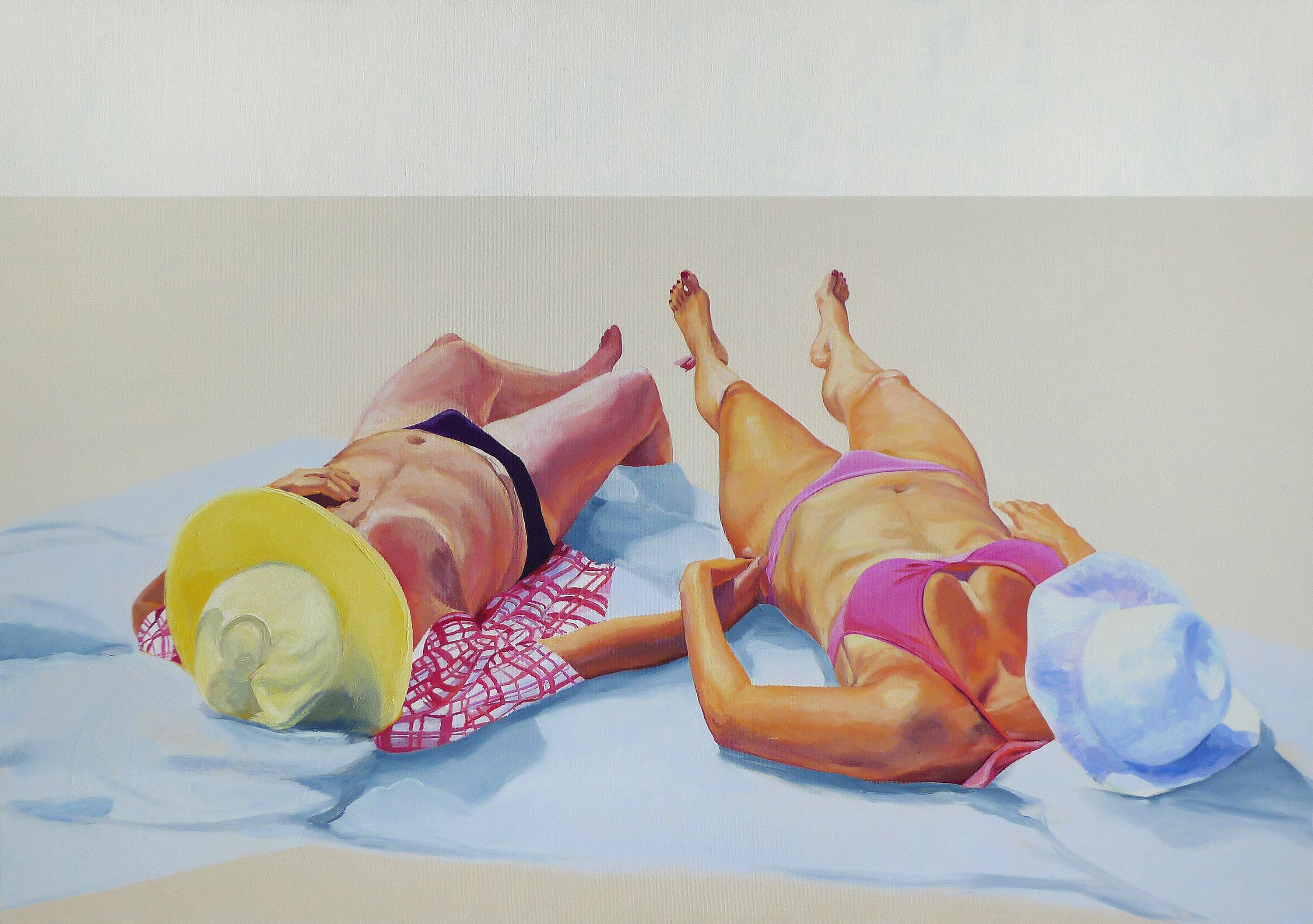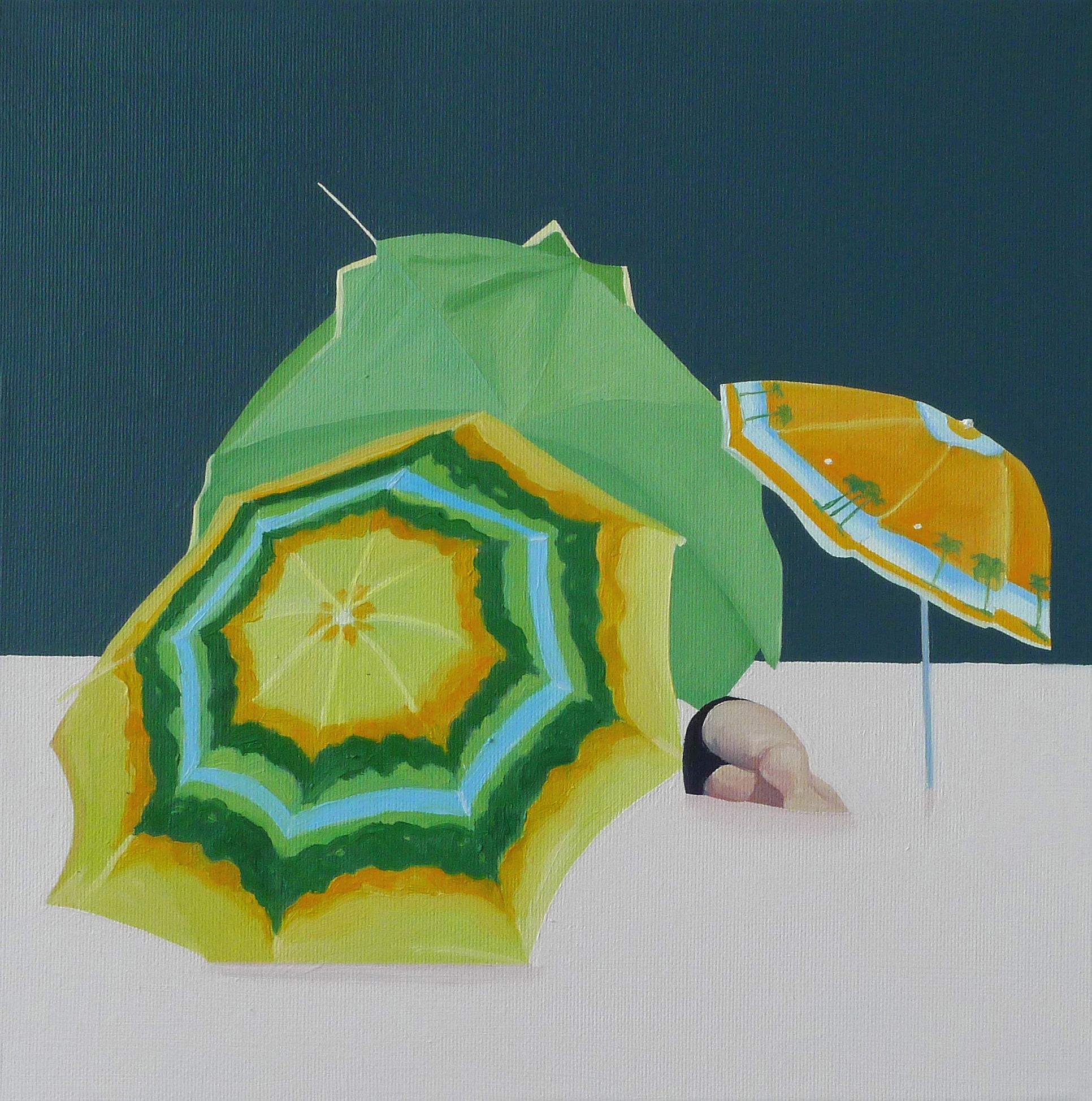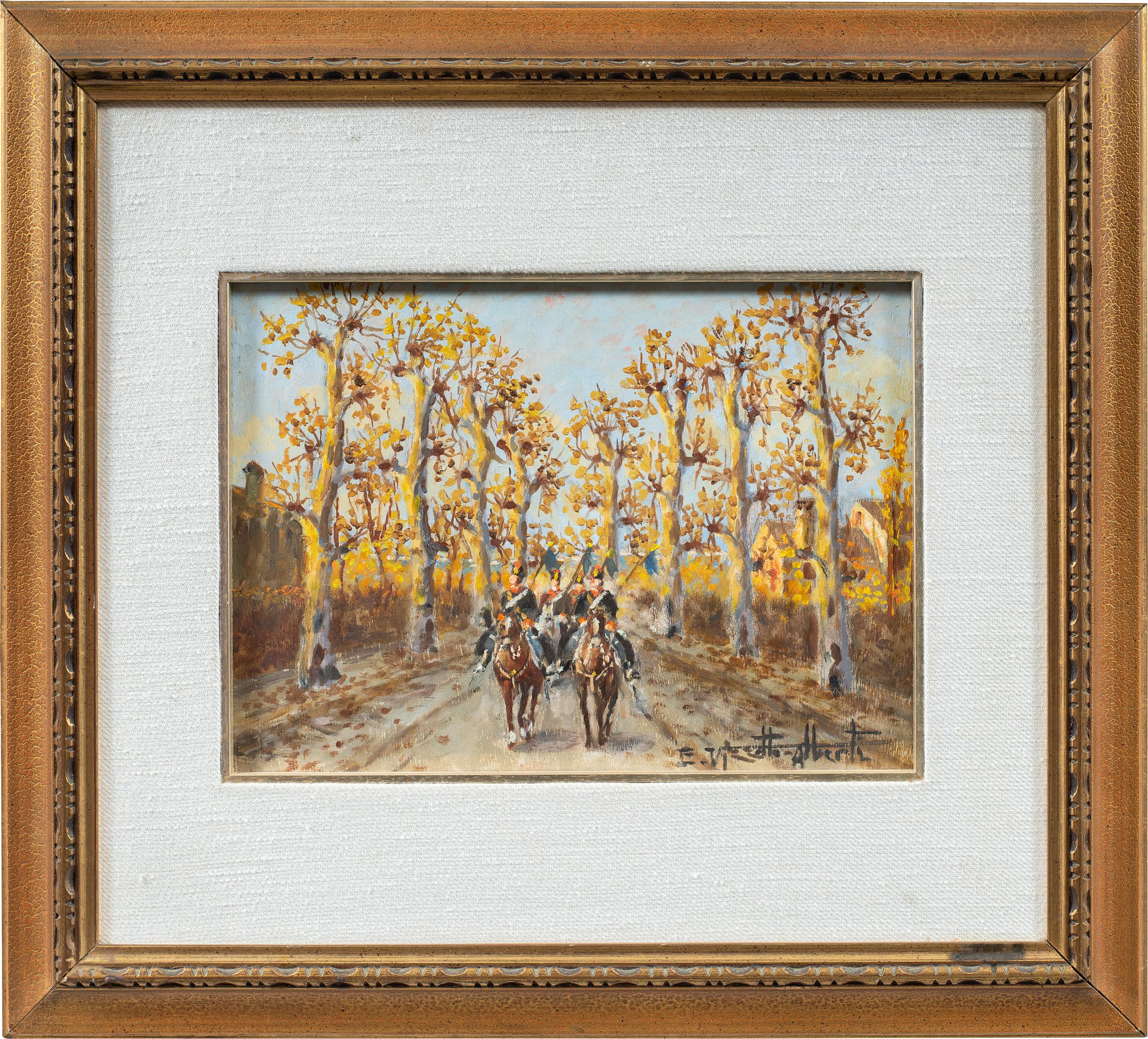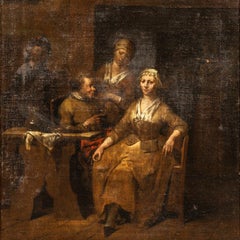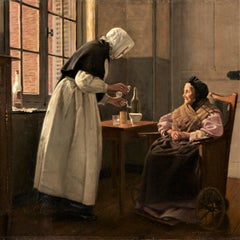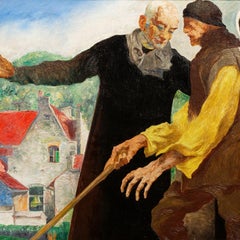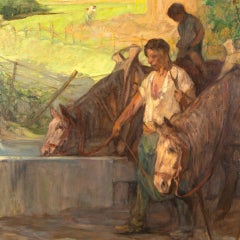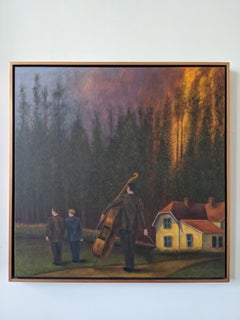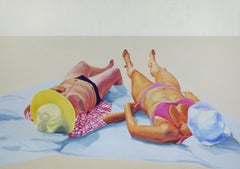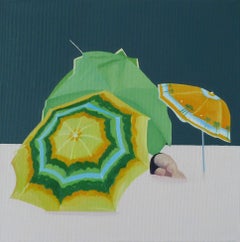Items Similar to Riders and Bedouins walking on a path near a cliff, Oil on panel by Honoré BOZE
Want more images or videos?
Request additional images or videos from the seller
1 of 17
Honoré BozeRiders and Bedouins walking on a path near a cliff, Oil on panel by Honoré BOZE
About the Item
Cavaliers et bédouins marchants sur un chemin près d’une falaise.
(panneau 32 *20 cm)
Honoré Boze est un peintre orientaliste français, né à l'île Maurice le 19 avril 1830, et mort à Marseille le 5 janvier 1909 (à 78 ans). Petit-neveu du peintre Joseph Boze, Honoré Boze est né à l'île Maurice d'un père provençal et d'une mère hindoue d'une grande beauté. Son père, capitaine de navire et négociant à l'Île-Maurice, qui deviendra maire orléaniste de Martigues et conseiller général de Bouches-du-Rhône, obligé de quitter la Provence, l'emmena à Paris où il put parcourir les expositions et les Salons. Il se prit de passion pour l'orientalisme des peintures d'Eugène Fromentin.
Il est revenu ensuite en Provence avec son père. Il s'est alors inscrit comme élève à l'École des beaux-arts de Marseille avec comme directeur Émile Loubon et dont il a suivi les cours.
Il s'est marié avec une veuve ayant des propriétés à Oran. Il a alors pu faire des voyages en Algérie où il a trouvé de nombreux sujets pour ses tableaux. Il est élu à l'Académie de Marseille en 1900.
Collections publiques
Musée des Beaux-Arts de Marseille : Portrait de Mme Veuve Loubon, Portait du sculpteur Aldebert. Paris, Musée du quai Branly - Jacques Chirac : Campement des cavaliers arabes près de Tlemcen, Algérie, 1872, huile sur toile.
- Creator:Honoré Boze (1830 - 1908, French)
- Dimensions:Height: 20.48 in (52 cm)Width: 15.75 in (40 cm)
- Medium:
- Period:
- Condition:
- Gallery Location:Gent, BE
- Reference Number:1stDibs: LU2140213785932
About the Seller
5.0
Vetted Professional Seller
Every seller passes strict standards for authenticity and reliability
Established in 2018
1stDibs seller since 2022
- ShippingRetrieving quote...Shipping from: Gent, Belgium
- Return Policy
Authenticity Guarantee
In the unlikely event there’s an issue with an item’s authenticity, contact us within 1 year for a full refund. DetailsMoney-Back Guarantee
If your item is not as described, is damaged in transit, or does not arrive, contact us within 7 days for a full refund. Details24-Hour Cancellation
You have a 24-hour grace period in which to reconsider your purchase, with no questions asked.Vetted Professional Sellers
Our world-class sellers must adhere to strict standards for service and quality, maintaining the integrity of our listings.Price-Match Guarantee
If you find that a seller listed the same item for a lower price elsewhere, we’ll match it.Trusted Global Delivery
Our best-in-class carrier network provides specialized shipping options worldwide, including custom delivery.More From This Seller
View AllThe Matchmaker, oil on canvas by Jan Baptist Lambrechts
By Jan Baptist Lambrechts
Located in Gent, VOV
Jan Baptist LAMBRECHTS (Antwerp, 1680 - after 1731), L'entremetteuse Canvas. On verso, wax stamp. 40 x 31 cm Expert : M. René MILLET
Lambrechts was born in Antwerp in 1680. His fathe...
Category
17th Century Figurative Paintings
Materials
Canvas, Oil
Afternoon tea , 1912 Oil on canvas Auguste Moreau-Deschanvres (1838-1913)
Located in Gent, VOV
Auguste Moreau-Deschanvres (1838-1913)
A student of Julien Potier at the Valenciennes academic schools, the painter Auguste Moreau-Deschanvres (1838-1913) lived in the house-studio h...
Category
20th Century Figurative Paintings
Materials
Canvas, Oil
The blind man, oil on canvas by Maurice Langaskens
By Maurice Langaskens
Located in Gent, VOV
A masterfully painted scene originating from the artist's studio
In this painting, Langaskens brings together several motifs that were also the subject of his graphic work: the blind man, the priest, the nun and the farm that also appears in the famous etching "les toits rouges" (the red roofs). These elements are brought together in a dynamic and colourful composition, where the similarities to that other Belgian painter, Anto Carte, are striking.
Combining these elements in this way creates a certain tension. Is the work about mercy (helping a blind man), or are we spectators of a scene where a poor wretch's purse is stolen?
Striking is the use of impasto, in which the painter emphasises the texture of fabrics and skin via flowing lines.
Maurice Langaskens 1884 - 1946 Biography
A Belgian painter and printmaker, Maurice (Maurits) Langaskens enrolled in the Académie Royale des Beaux-Arts in Brussels in 1901, and was trained as a decorative painter by the leading Belgian muralist and sculptor Constant Montald. From early on, Langaskens was recognized as a fine draughtsman, and won several prizes at the Académie. After living and studying for a few months in France in 1906, mainly in Dijon, the young Langaskens settled in Schaerbeek, outside Brussels. He began his independent career in 1907, when he exhibited three decorative paintings at the Salon in Brussels for the first time and also had an exhibition of his work shown at the Salle Boute in the city. The following year he contributed six paintings to the 16th annual exhibition of the Belgian artist’s association ‘Pour l’Art’ in Brussels, where he was to exhibit frequently over the course of his later career, until 1941. (Langaskens also designed the poster for the 17th ‘Pour l’Art’ exhibition in 1909.) Also in 1908, one of his paintings was selected for an exhibition of modern Belgian art in Berlin. Much of Langaskens’s early work was in a vibrant and visually arresting Art Nouveau or Symbolist style. This bold and colourful manner also translated well into large-scale mural commissions, and he soon became one of the leading painter-decorators of the early 20th century in Belgium. His decoration of the town hall of the city of Zoutleeuw in 1912 earned the artist considerable fame and the praise of his teacher and mentor Montald: ‘He was one of the best students in the class; today he is the most outstanding artist among the decorators of our time.’ The same year the first of several exhibitions of Langasken’s work was mounted at the Cercle Artistique et Littéraire in Brussels. The outbreak of the First World War, however, brutally interrupted the rise of the artist’s successful career. Drafted into the Belgian army at the beginning of August 1914, Langaskens was captured by the Germans after less than a fortnight. He spent the next three and half years as a prisoner of war, at internment camps at Sennelager, Münsterlager and Göttingen. He produced numerous, mostly small-scale paintings and watercolours of portraits and depictions of many of his fellow prisoners, as well as scenes of daily camp life, that are today regarded as among his finest and most personal works. It was also during this period that he painted two of his best-known pictures, the large canvas In Memoriam, painted in 1916 and depicting the burial of a Belgian soldier by his comrades, and the monumental triptych Repose en Paix, painted between 1915 and 1918. After his liberation and return to Belgium, Langaskens exhibited over eighty of the paintings and drawings that he had produced as a prisoner of war at the Galerie Sneyers in Brussels in 1918. After the Armistice, Langaskens - suffering from aphasia and nervous disorders brought about by his long confinement - painted mainly easel pictures of winter landscapes, rustic genre scenes and floral subjects, and also produced a number of designs for tapestries, book illustrations and stained-glass windows. Within a few years, however, his health had recovered and he returned to undertaking large-scale decorative mural commissions. In 1920 Langaskens was one of the founders, alongside Montald, Jean Delville, Emile Fabry...
Category
20th Century Figurative Paintings
Materials
Canvas, Oil
Horses resting at the watering place Oil on canvas by Jules Pierre Van Biesbroec
Located in Gent, VOV
Horses resting at the watering place Oil on canvas by Jules Pierre Van Biesbroeck
Jules Van Biesbroeck was born in Italy in 1873 during h...
Category
20th Century Figurative Prints
Materials
Canvas, Oil
Boy with a flute
By Leon Herbo
Located in Gent, VOV
Léon HERBO (1850-1907), Young boy with a flute, oil on canvas, signed upper left and dated 1879. This painting seems inspired by the painting "Singing Boy with a Flute" by the Dutch ...
Category
Late 19th Century Dutch School Figurative Paintings
Materials
Canvas, Oil
Children playing in a forest
Located in Gent, VOV
Amédée Elié Servin — (1829-1884) : Children playing in a forest
A nice and confidently painted scene of three children playing in the midst of a dark forest. Through clever use of colour and light and dark effects, Elié Servin creates a mysterious and fairytale-like scene in which all attention is drawn to the playing children.
Amédée-Élie Servin (1829-1884)
Servin Amédée-Élie was a French painter and engraver, founder of the artistic community of Villiers-sur-Morin.
Servin was born to a tanner, who, disappointed by his son's failure in his studies, apprenticed him to an upholsterer where he learned to draw cartoons. He then entered the École des Beaux-Arts and studied under the painter Michel Martin Drolling. At this school, he befriended students of his generation, such as Jean-Jacques Henner, Benjamin Ulmann and Paul Baudry...
Category
1880s French School Figurative Paintings
Materials
Oil, Canvas
You May Also Like
Large oil on Canvas Painting -- Titanic Overture
By Gary Masline
Located in Troy, NY
This oil on canvas painting is an example of the artist's fascination with the moments just before something unexpected happens. The painting gives a scene often enacted in Northeast...
Category
2010s Contemporary Landscape Paintings
Materials
Canvas, Oil
$5,200 Sale Price
35% Off
The Prayer - Modern Figurative Oil Painting, Beach View, Landscape, Sunshade
By Julita Malinowska
Located in Salzburg, AT
Artodyssey
"Julita Malinowska's paintings belong to those, which once seen - are never forgotten. The open spaces, sometimes cool and bright, at other times heavily saturated with co...
Category
2010s Contemporary Figurative Paintings
Materials
Canvas, Oil
Couple 2 - Contemporary Figurative Oil Painting, Joyful, Sun, Beach, Sunbathing
By Julita Malinowska
Located in Salzburg, AT
Artodyssey:
"Julita Malinowska's paintings belong to those, which once seen - are never forgotten. The open spaces, sometimes cool and bright, at other times heavily saturated with c...
Category
2010s Contemporary Figurative Paintings
Materials
Canvas, Oil
Sunshades - Contemporary Figurative Oil Painting, Beach View, Colourful, Joyful
By Julita Malinowska
Located in Salzburg, AT
Artodyssey
"Julita Malinowska's paintings belong to those, which once seen - are never forgotten. The open spaces, sometimes cool and bright, at other times heavily saturated with co...
Category
2010s Contemporary Figurative Paintings
Materials
Canvas, Oil
Vizzotto Alberti (Venetian realist painter) - early 20th century figure painting
Located in Varmo, IT
Enrico Vizzotto Alberti (Oderzo 1880 - Padua 1976) - The 7th regiment of Milan lancers.
25.5 x 35 cm without frame, 51.5 x 57 cm with frame.
Ancient...
Category
Early 20th Century Art Nouveau Landscape Paintings
Materials
Canvas, Oil
$808 Sale Price
53% Off
Free Shipping
Shepherd in the Pyrenees Spain oil on canvas painting spanish landscape Europe
By Enric Porta Mestre
Located in Barcelona, Barcelona
Title: Shepherd in the Pyrenees
Artist: Enric Porta i Mestre (1898–1993)
Technique: Oil on canvas
Style: Post-Impressionism with Expressionist influences
Dimensions:
Unframed: 23.6 x 31.9 in
Framed: 29.9 x 38.2 in
Signature: Signed in the lower right corner as "E. Porta".
Date: 1956 (according to the inscription on the back).
DESCRIPTION OF THE WORK
Shepherd in the Pyrenees by Enric Porta i Mestre depicts a rural scene with a striking sense of introspection and evocative charm. The painting portrays a shepherd tending to his flock amidst the mountainous landscape typical of the Catalan Pyrenees. The composition captures the serenity and beauty of nature through vibrant colors and dynamic brushstrokes.
The work reflects a Post-Impressionist style with loose, bold strokes and vivid tones, combined with Expressionist influences in its ability to evoke emotions beyond the physical depiction. The energetic and textured brushwork infuses the painting with a lively rhythm, while the rich palette of greens and blues immerses the viewer in the landscape's tranquil atmosphere.
In this piece, Porta i Mestre showcases a mastery of color and light, illustrating his deep connection to his homeland and its rural life, which served as a source of inspiration throughout his career.
ARTIST BIOGRAPHY
Enric Porta i Mestre (La Pobla de Segur, 1898–1993) was a Catalan painter known for his landscapes, still lifes, and costumbrist depictions. Trained in Lleida and Barcelona, Porta debuted in 1922 with an exhibition in the Catalan capital. He later moved to Paris to further his artistic studies, where he connected with avant-garde artists such as Miquel Villà...
Category
1950s Post-Impressionist Landscape Paintings
Materials
Canvas, Oil
Recently Viewed
View AllMore Ways To Browse
Maurice Jacque
Veuve Art
Jacques Antiques
Paintings Pre 1900
Framed Toile
Art Antique Pre 1900 Paintings
Arab Portrait
1900s Oil On Canvas Portrait
Bedouin Art
Tableaux Antique
Bedouin Painting
Cavalier Portrait
Antique Aly
Portrait Antique Pre 1900 Paintings
Maurice Pre
Maurice Antiques
Les Cavaliers
Antique Oil Paintings Antique Pre 1900 Paintings

